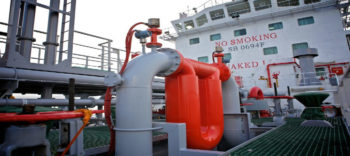
Singapore, the world’s largest bunkering port, will enforce the use of mass flow meters (MFM) for bunkering operations from 1 January 2017, making it the first port in the world to mandate the use of such fuel measuring device.
The Maritime and Port Authority of Singapore (MPA) has been steering Singapore to adopt the use of MFM since 2014, as the regulator has been actively engaging the industry to prepare for the operational transformation and working with technical committees to draw up new bunkering standards.
The MFM is in fact not a new technology as they are already widely used in landbased power plants, but they are new to the marine industry, which up to today continues to rely on manual fuel measurements such as tank dipping and sounding.
The fuel quantity variance of using MFM is estimated at a maximum of 0.5%, lower than the traditional sounding tape method of up to 0.7%.
The benefits of using MFM in bunkering include enhanced transparency to reduce malpractices and disputes, greater efficiency with time savings and higher productivity for quicker bunker tanker turnaround without the need to expand port capacity.
The use of the meters has been proven to reduce bunkering time by about 2-3 hours per vessel and increase bunker tanker turnarounds to 10-12 times a month from the present eight on average.
Bunker deliveries conducted using the meters, however, will apply only for high-viscosity grade bunker fuel deliveries, excluding the low-viscosity marine gas oil (MGO). The MPA has said that it will follow up on a compulsory implementation of MFM for MGO sometime in early 2017, as tests are already underway and results so far have been encouraging.
There will be an estimated 132 fuel oil bunker tankers fitted with MFM to carry out bunker deliveries, allowing Singapore to continue meeting demand volumes every month.
Singapore is the runaway leader in bunker fuel sales with 45.2m tonnes sold in 2015, and volumes sold in January-November 2016 have reached 44.71m tonnes, up 838% year-on-year, according to MPA statistics.
The cost of installing MFM on bunker tankers can range from a low of $30,000 to a high of $200,000, depending on the condition of the vessel. The MPA has offered assistance to the industry with a lump sum incentive of SGD80,000 ($55,200) for each existing bunker tanker delivering fuel within port waters.
With the new regulation in place and a ready fleet of Singapore-flagged MFM-fitted bunker tankers, ships buying bunker fuels in Singapore from 2017 would have to agree to the meter readings of the MFM installed on the bunker tankers.
A technical reference standard for MFM, termed the TR48:2015, was launched in February this year. The standard covers a set of core requirements for metering system qualification, installation, testing procedures and documentation for bunker custody transfer using MFM.
The technical reference has been developed under the auspices of the Technical Committee (TC) for Bunkering of the Chemical Standards Committee (CSC). Back in March 2009, the TC for Bunkering agreed to undertake the MFM project and to form a Working Group to develop the standard.
While the MFM process of bunker custody transfer from bunker tankers to receiving vessels is ready for commercial practice, one grey area remains and that is the fuel custody transfer from onshore oil terminals onto the receiving bunker tankers. Terminal operators, like shipowners, are not bounded by the MFM regulation and bunker suppliers have questioned whether they will accept the readings on the bunker tankers’ MFM, in the event of a major quantity difference.
A source familiar with the matter told Seatrade Maritime News that the TC and the relevant regulators are aware of this missing piece of jigsaw in the entire MFM bunkering chain, but it is not a stumbling block as all custody transfer meters used in terminals follow requirements set by national standards and conformance body SPRING Singapore, which has similar requirements for MFM.
Copyright Ships & Ports Ltd. Permission to use quotations from this article is granted subject to appropriate credit given to www.shipsandports.com.ng as the source.
